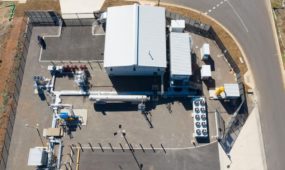Renewables proposed to power major outback mine
Renewables
Australian mining company Oz Minerals plans to power its proposed West Musgrave copper nickel mine in central Australia with up to 80 per cent renewables.

Sign up to receive notifications about new stories in this category.
Thank you for subscribing to story notifications.

The South Australian company released a pre-feasibility study today showing the Nebo-Babel deposit has the potential to produce 28,000 tonnes of copper and 22,000 tonnes of nickel a year for 26 years.
The project is a joint venture between Adelaide-based OZ Minerals (70 per cent) and Perth-based explorer Cassini Resources (30 per cent). If it goes ahead, the mine would be the first in the broader West Musgrave province, which is in Western Australia not far from its border with South Australia and the Northern Territory.
Oz Minerals is also aiming for the mine to be powered by up to 80 per cent renewable energy and have a reduced carbon footprint with fewer people on site and a smaller accommodation village courtesy of a remote operations centre.
Should the renewables option be implemented, West Musgrave would become one of the largest fully off-grid, renewable powered mines in the world.
The company announced the findings to the Australian Securities Exchange this morning, resulting in a 2.5 per cent increase in its share price to $10.32.
OZ Minerals CEO Andrew Cole said the study confirmed the project can be a low carbon, low cost, long life mine producing copper and nickel, both in-demand minerals for the renewable and electrification industries.
“Building a viable asset in a remote part of Australia is challenging, but through our collaborative approach we have developed innovative off-grid renewable power and processing solutions, increased stakeholder awareness and involvement in the project and we have built confidence in the mineral resource itself,” he said.
“We are pleased the study has identified a means for us to reduce the project’s carbon footprint significantly and overcome the historical challenge of affordable power for West Musgrave.
“We believe, supported by the views of potential renewable energy suppliers, that 70-80 per cent of the power needs for West Musgrave can be supplied by renewable sources, supplemented by battery storage and diesel or trucked gas fired generation.”
OZ Minerals describes itself as a modern mining company and has major copper-gold mines, Prominent Hill and Carrapateena, operating in South Australia.
The West Musgrave pre-feasibility study base case assumes the power solution will be outsourced to a third party, with power purchased back over the life of the asset.
The company proposes a 50MW base case power supply is proposed utilising a hybrid solar-wind-battery-diesel solution, although a gas pipeline remains a secondary option. Baseline data collected since 2018 has demonstrated a high quality, consistent solar and wind resource is available, with higher wind velocities at night offsetting the lack of solar.
Modelling has demonstrated that circa 70 – 80 per cent renewables penetration can be achieved for the site, with the current mix modelled to be an optimised mix of wind, solar and diesel supported by a battery installation. The company estimates the solution would result in the avoidance of in excess of 220,000tpa of carbon dioxide emission compared to a fully diesel-powered operation.
South Australia leads the nation in the uptake of wind energy and roof-top solar with renewable sources accounting for more than 50 per cent of the electricity generated in the state.
Last June, Oz Minerals announced the Energy and Mining Collaboration (EMC) with six other organisations – Adelaide University, CSIRO, the Department of Energy and Mining, the Rocky Mountain Institute, SunSHIFT and the Tonsley Innovation Precinct.
The collaboration is investigating renewable energy and demand management related activities on a mine site, with a view to developing and identifying opportunities for an international showcase that optimises electrical and fuel demand and the integration of renewable energy systems.
The program’s first project is a trial installation of a 250 kW hybrid energy solution facility including solar, wind and a battery in the first half of 2020, located at the Carrapateena mine site and have a Smart Grid controller for data access and tracking.
OZ Minerals’ Carrapateena project in South Australia began concentrate production in December and will ramp up to full production over the next 18 months.
The Nebo-Babel deposits were discovered by Western Mining in 2000 and acquired by BHP in 2005. In 2014 Cassini Resources acquired the project and set about an extensive drilling and study program culminating in a 2015 Scoping Study. In 2016 OZ Minerals entered into a Joint Venture with Cassini and a Further Scoping Study was completed in late 2017. Since then OZ Minerals has increased its ownership of the project to 70 per cent by reaching expenditure thresholds.
“During 2019 sufficient drilling has been completed to allow the declaration of a maiden Ore Reserve of 220Mt at 0.36 per cent copper and 0.33 per cent nickel, which is underpinned by the Pre-Feasibility Study,” Cole said.
“We are pleased the study has identified a means for us to reduce the project’s carbon footprint significantly and overcome the historical challenge of affordable power for West Musgrave.”
OZ Minerals will continue to sole fund the Nebo-Babel studies until the feasibility study and decision to mine are delivered as per the current agreement with Cassini.
Jump to next article



